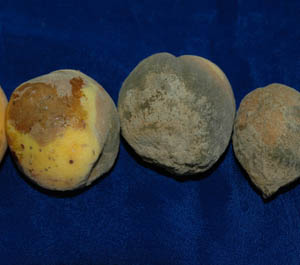Brown Rot of Stone Fruits | |
|---|---|
| July 10, 2008 | |
|
Stone fruits such as cherry, peach, apricot, and plums have been hit hard this year with brown rot. Ornamental members of the Prunus genus have been affected as well. The causal fungus, Monilinia (Sclerotinia) fructicola, thrives where spring and summer rains are frequent. Although it is dry in many areas of Illinois now, rain was plentiful when infection occurred on blossoms and tender shoots. We have seen cases of brown rot on edible and ornamental Prunus species alike this year. Brown rot causes fruit to become brown and decayed. Eventually, it is covered with gray spore tufts. As the fruit rots, it retains its shape but becomes shriveled and dry, earning the name “mummy berries.” The images show brown rot on cherry and peach fruit.   Infection may also occur on flowers or small stems. Cankers caused by this fungus are eventually covered in gray spore masses. If the cankers girdle the stems, dieback occurs. This stage has some lasting effect on ornamental Prunus species in the form of dieback. Still, it should not be life-threatening to the tree. The pathogen lives over winter in cankers or on mummified berries, either in the tree or on the ground. Obviously, removal of these berries is helpful in reducing innoculum for the next year. Disease control for edible stone fruits usually focuses on removing mummified berries and applying fungicides. The most critical time for fungicide application is from the time blossom buds show pink through flowering and again when the fruit begins to color. Many fungicide options are listed in the Midwest Tree Fruit Spray Guide for commercial growers and the Home, Yard, & Garden Pest Guide for home growers. Take a look at these now, and plan to spray next year. It is likely you will see the disease again. Those having problems with brown rot, blossom rot, and twig blight on their ornamental Prunus species can spray when first blossoms open, during full bloom, and again at petal fall. For details about this disease, read the Report on Plant Disease at http://www.ag.uiuc.edu/~vista/abstracts/a804.html. | |
| Author: | Nancy Pataky |
